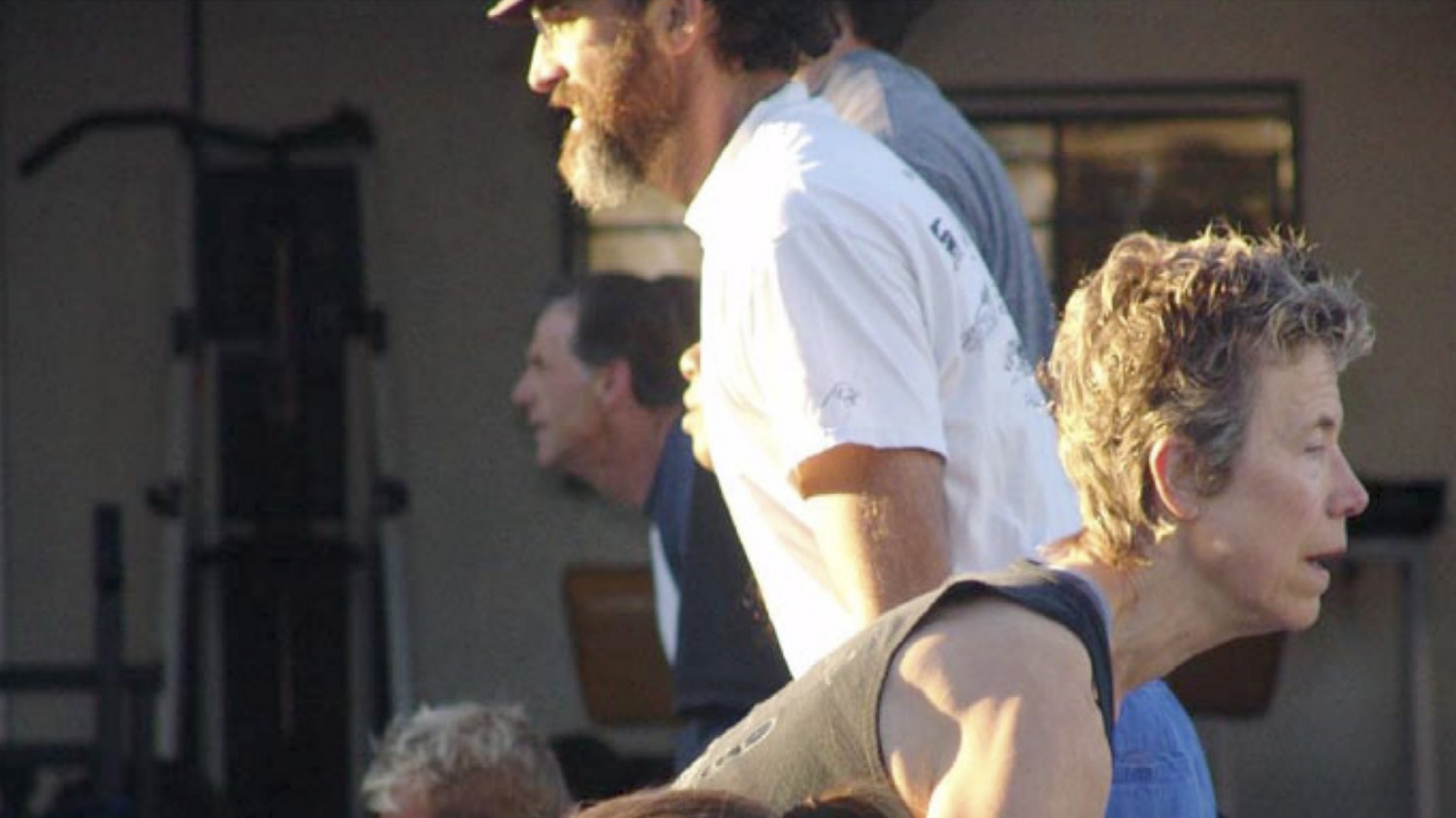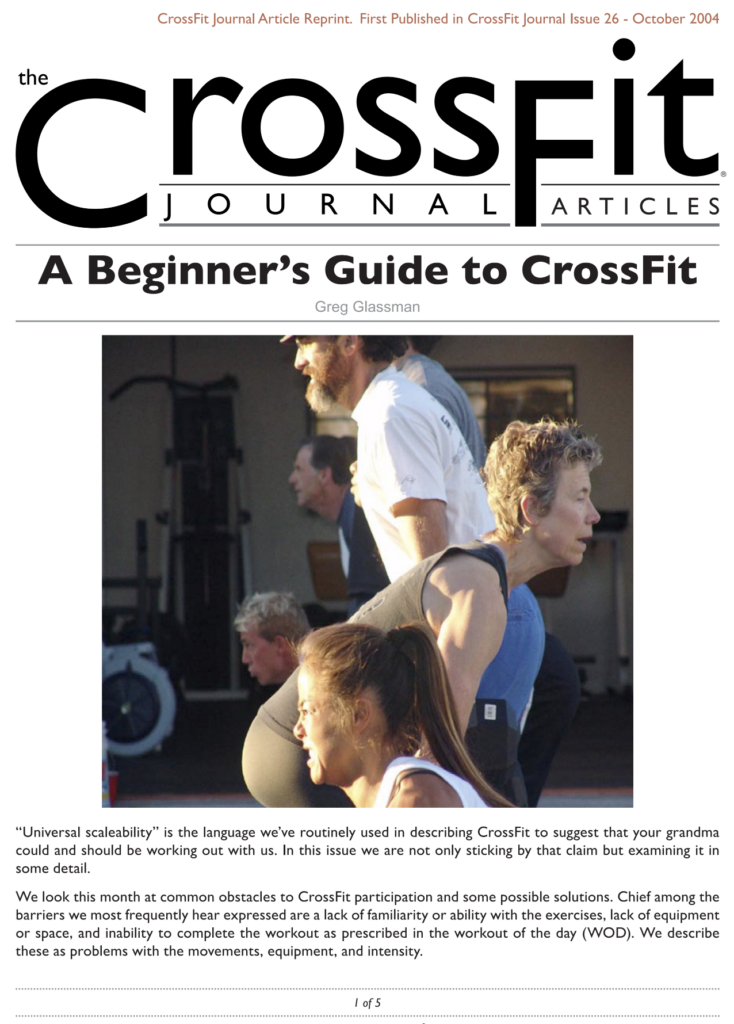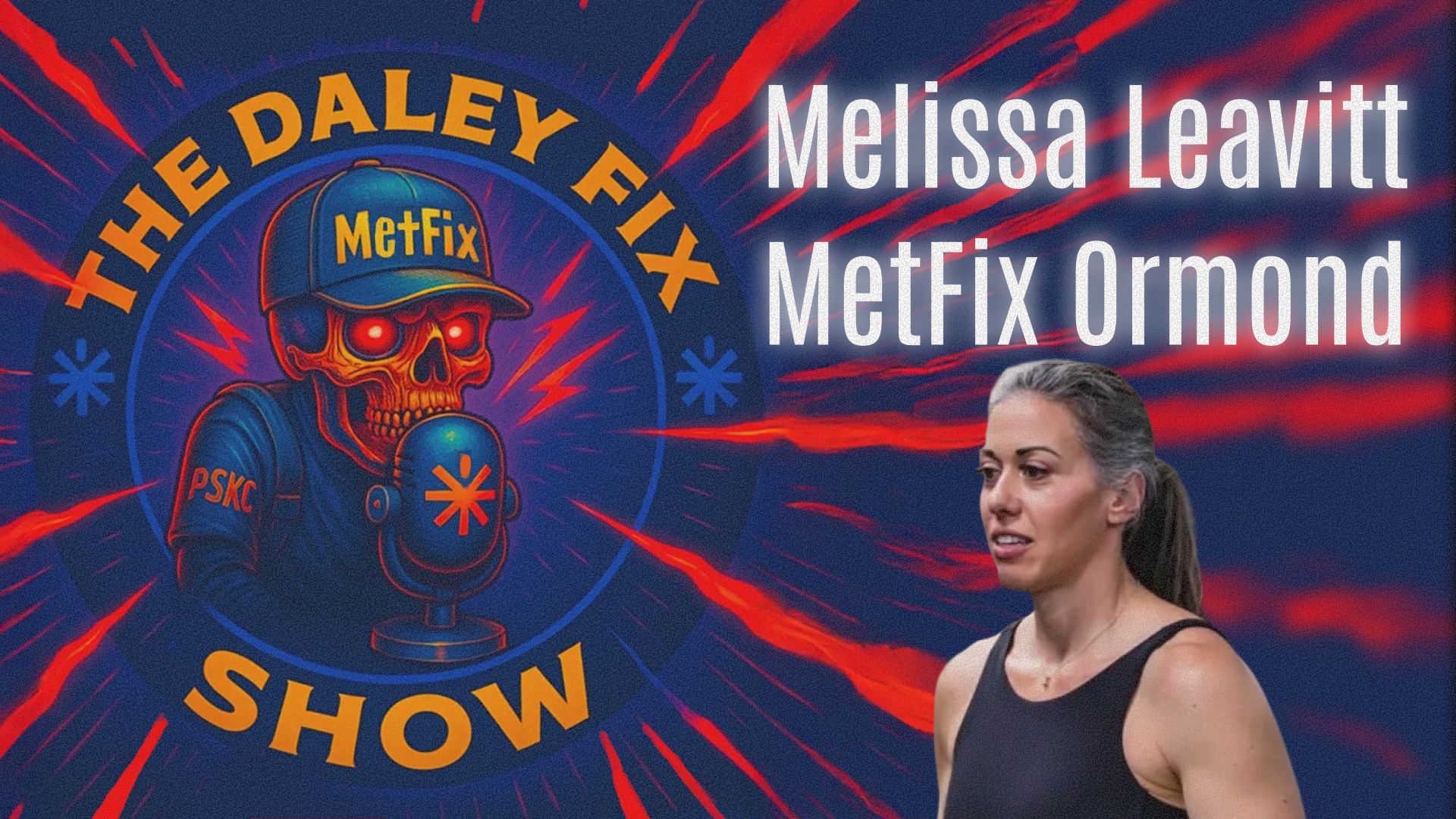“Universal scaleability” is the language we’ve routinely used in describing CrossFit to suggest that your grandma could and should be working out with us. In this issue we are not only sticking by that claim but examining it in some detail.
We look this month at common obstacles to CrossFit participation and some possible solutions. Chief among the barriers we most frequently hear expressed are a lack of familiarity or ability with the exercises, lack of equipment or space, and inability to complete the workout as prescribed in the Workout of the Day (WOD). We describe these as problems with the movements, equipment and intensity.
Before looking at these barriers and their solutions let’s further set the stage for our discussion with three ancillary points, the first of which is important to all new CrossFitters and the second and third important for veterans, many of whom we know have been frustrated by trying to introduce CrossFit to their friends, colleagues or family.
First, over the past three years thousands of people have acquainted themselves with the CrossFit website, gotten the hang of our core theme of “functionality, intensity and variance,” learned our basic exercises, acquired most of our equipment, and made amazing physical gains. Included among these self-starters are many who were initially challenged to participation by varying combinations of advanced age, being self-taught, poverty, inexperience, disability and fear.
All of the strategies that we are offering this month have been fruitfully employed by a legion of CrossFitters left to their own devices and common sense—proving our stand on scaleability.
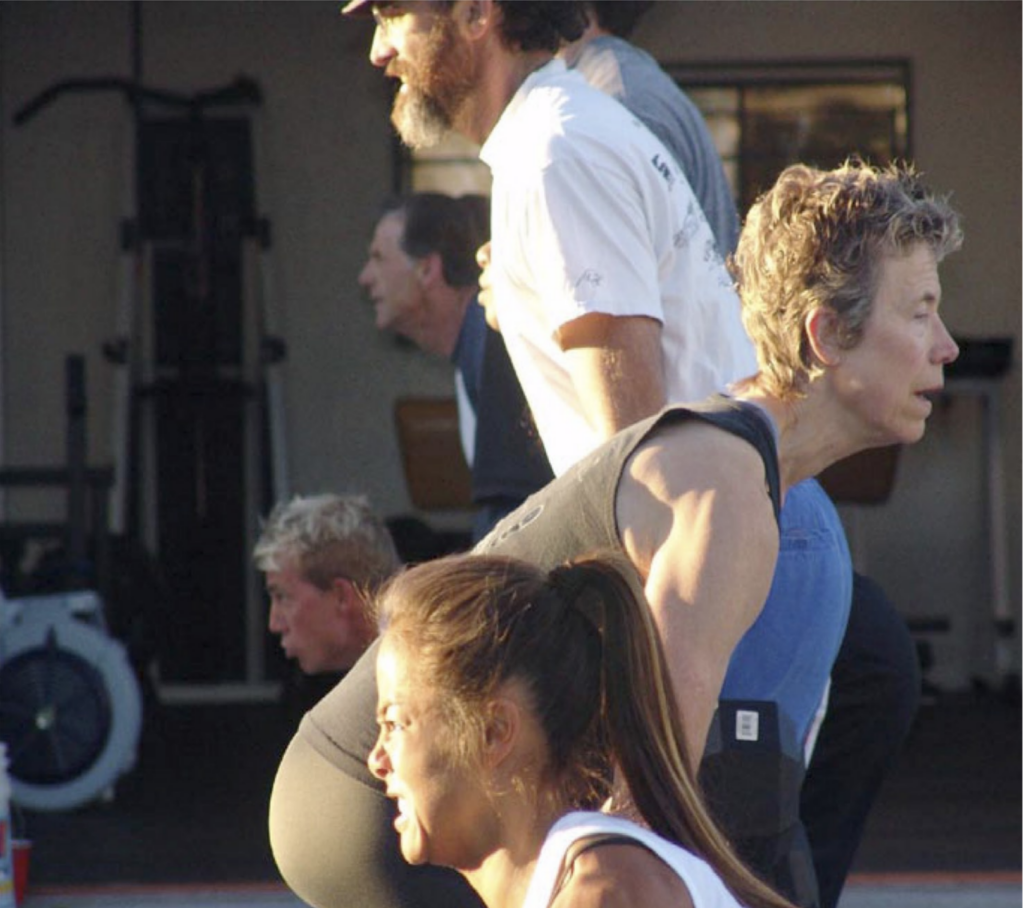
Second, if you are a regular reader of the CrossFit Journal it is more than likely that you are long past the 99th percentile for fitness even among those who regularly exercise. Our typical reader is seen by his friends, acquaintances and family members as, quite frankly, a freak—a fitness freak, but still a freak. Your endorsement may not carry the weight you would hope or think it would.
Your retching behind the garage after our workouts may not hold the attraction for your wife that it does for you. When you tell your fat sergeant that these workouts will bring him to his knees in five minutes, you may have just then vaccinated him for life against ever wanting to even try your program. Ironically, your legendary fitness status may render you bizarrely unqualified for lending advice to your mortal friends.
Third, CrossFit presents a fitness model that is contrary to popular practice and is, therefore, for most people, scary. Nearly every aspect of our model is at odds with the fitness magazines and programming in commercial facilities. For too many people there is no greater fear than being out of step with the rest of their community. The terrible pain of “looking funny” at Gold’s or 24- Hour Nautilus while “training like no one else” has made its way to our desk in dozens of emails.
Doing CrossFit makes you a leader in the fitness community. You CrossFit veterans have scooped most of the world’s best-known trainers and coaches—be patient with your friends, co-workers, family and fellow athletes.
For you beginners, unfamiliarity with our exercises, lack of equipment or the blistering demands of the WOD are not the obstacles they might seem. Let’s give perspective and then offer solutions to the problems with movements, equipment and intensity separately.
CrossFit is based extensively, if not exclusively, on functional movements. (See “What Is CrossFit?” in the CrossFit Journal for our perspective on functional exercise.) As daunting as learning to snatch, clean, overhead squat, jerk and muscle-up may be, especially never having heard of them, they, like the rest of the CrossFit exercises, are movements that largely mimic and reproduce natural efforts like standing, throwing, lifting, pulling, climbing, running and punching.
There is no circumstance of disability, gender, age, stature, weight or fitness level that reduces the need, safety or effectiveness of functional movement. This is not the same as saying that everyone should do muscle-ups or even squats. Where muscle-ups are impossible, substituting pull-ups and dips largely preserves the training stimulus and prepares for the muscle-up. Where the hip and legs are too weak to squat, hanging on to a rope or racked bar with the arms for assistance largely preserves the training stimulus and prepares for the squat.
Every functional exercise contains an essential bit of human capacity. Due to strength or injury, often a particular exercise is not immediately possible. In nearly every case what we do is find a method to reduce the load to insignificant levels while preserving precisely the line of action or substitute movements of similar lines of action that will prepare for the missing capacity.
Any weightlifting exercise can be done with a broomstick or PVC pipe. Every bodyweight exercise can be substituted with gateway movements. Look what we can do with one of our more challenging workouts, “Diane.” Diane is a couplet of 225-pound deadlifts and handstand push-ups for rounds of 21, 15 and 9 reps each. You have to be pretty fit to even finish the workout, much less do it in Matt Mast’s 3:41. If we substitute light dumbbell shoulder press for the handstand push-ups and use a broomstick for the deadlifts we could take that workout to the senior center.
All of the weightlifting movements can be safely, enjoyably and productively self-taught. A coach or trainer is nice, but not always available. The key is committed study and practice of the basic movements. The resources available on and through the internet are fantastic. Those who take a keen interest in these movements have been able to quickly establish safe and effective lifts. Much too much has been made of the potential for injury. In our view the benefits of learning the CrossFit lifts far outweigh the risks of learning them—even at home alone and uninitiated.
The CrossFit approach is to embrace, study, practice and train for functional mastery. CrossFitters at every level are on the same path—moving from functional competence to functional dominance. Our almost complete reliance on functional movements is vital to the potency of the CrossFit protocol. We say, “The magic is in the movements.”
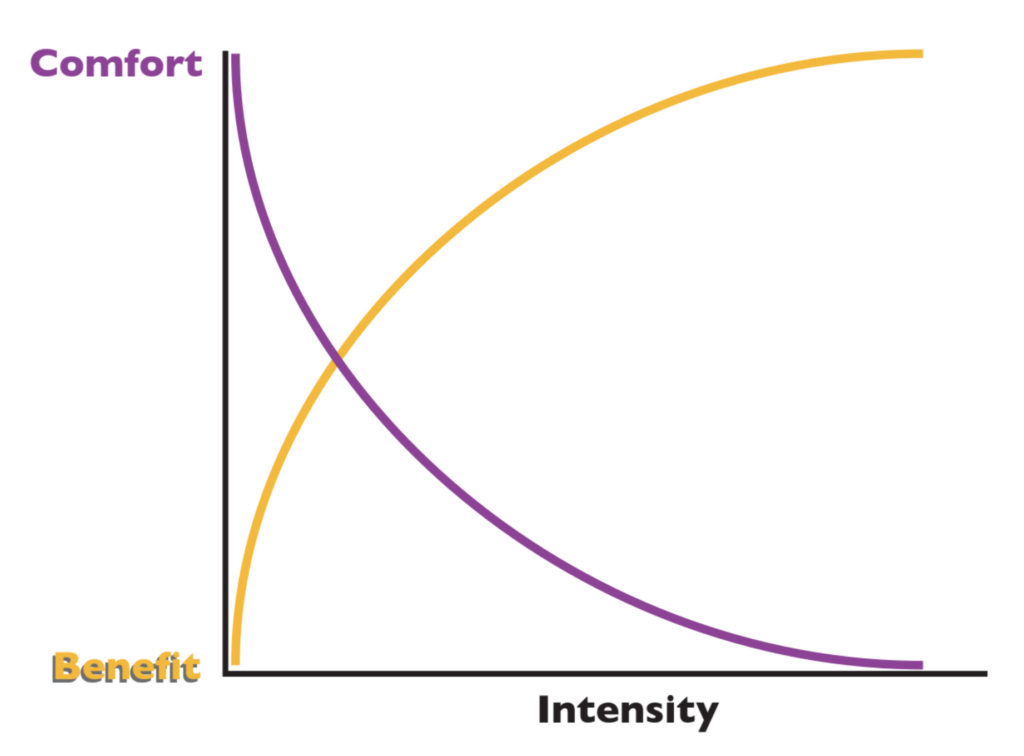
Where functionality defines the CrossFit path, it is intensity that most controls the rate of progress for any particular individual. Intensity is essentially the rate of work or power expressed in completing work. It correlates to heart rate and how quickly you complete any WOD where we’re looking for time to completion.
The WOD is responsible for quite a bit of confusion about the CrossFit method. CrossFit is a strength and conditioning system built on constantly varied, if not randomized, functional movements executed at high intensity. The WOD is but one example, designed by CrossFit’s founders, of CrossFit programming. The WOD is designed to tax the capacities and improve the performance of athletes working at the outer margins of human capacity.
Not being able to complete a WOD doesn’t mean that you can’t do CrossFit. Taking a WOD and reducing the load, cutting the reps, dropping a set, taking longer rests and sitting down three times during the workout is still doing CrossFit. In making these modifications the athlete is merely turning down the intensity.
Strength and conditioning gains come fastest for athletes who hold the highest average intensity over sustained periods. Consistency must be established at any general intensity level before it is appreciably turned up, or the specter of burnout looms. Countless people have after three spectacular CrossFit workouts stated a preference for a fiery death over coming back for a fourth workout. They went too hard—too intense.
This brings us to a few final important points about intensity. Intensity and results are directly proportional, but intensity and comfort are inversely proportional. Choosing for greater intensity is choosing for more fitness, but, also, greater personal sacrifice in the form of discomfort. Expecting elite fitness from comfortable efforts is naïve, while going too fast is dooming. No formula can sort these issues out for you; the intuition of athletes and coaches everywhere has smartly outperformed all formalized approaches.
Knowing the taste and feel of intensity is no less than coming face to face with the real cost of elite fitness.
The natural movements which we believe everyone can readily learn, even on their own, require so little equipment, and our simple charter of functionality, intensity and variance gives so much latitude that resources cannot be a serious obstacle to CrossFit training.
With a pair of 15-pound dumbbells, 9 feet of rope and a pull-up bar you can adopt the CrossFit program. For about the cost of cable TV you can, over months, build a strength and conditioning facility that will support world-class programming.
Those disposed to handiwork have made rings, weights, plates, kettlebells, glute-ham developers and nearly every other piece of equipment we regularly use.
Space is a minor issue. CrossFitters are meeting in parks in Miami, building gyms in apartments and dorms, repurposing home garages, and corrupting the layout and gear of their local gyms everywhere.
The recurring themes in overcoming obstacles to CrossFit training are ingenuity, moderation and commitment. And nowhere is this better understood or expressed than within the community of CrossFitters who have on their own undertaking, with the same limitations and challenges found everywhere, grabbed the essence of the CrossFit concept and forged their best fitness.
These folks are found on the CrossFit Message Board and their ability and willingness to help is the beginner’s best resource. The board’s moderators support an environment where experts and beginners roost in friendship.
This article, by BSI’s co-founder, was originally published in The CrossFit Journal. While Greg Glassman no longer owns CrossFit Inc., his writings and ideas revolutionized the world of fitness, and are reproduced here.
Coach Glassman named his training methodology ‘CrossFit,’ which became a trademarked term owned by CrossFit Inc. In order to preserve his writings in their original form, references to ‘CrossFit’ remain in this article.
- Download Original PDF
- Download Español (Spanish) PDF
- Download Português (Portuguese) PDF
- Download Italiano (Italian) PDF
- Download Français (French) PDF
Greg Glassman founded CrossFit, a fitness revolution. Under Glassman’s leadership there were around 4 million CrossFitters, 300,000 CrossFit coaches and 15,000 physical locations, known as affiliates, where his prescribed methodology: constantly varied functional movements executed at high intensity, were practiced daily. CrossFit became known as the solution to the world’s greatest problem, chronic illness.
In 2002, he became the first person in exercise physiology to apply a scientific definition to the word fitness. As the son of an aerospace engineer, Glassman learned the principles of science at a young age. Through observations, experimentation, testing, and retesting, Glassman created a program that brought unprecedented results to his clients. He shared his methodology with the world through The CrossFit Journal and in-person seminars. Harvard Business School proclaimed that CrossFit was the world’s fastest growing business.
The business, which challenged conventional business models and financially upset the health and wellness industry, brought plenty of negative attention to Glassman and CrossFit. The company’s low carbohydrate nutrition prescription threatened the sugar industry and led to a series of lawsuits after a peer-reviewed journal falsified data claiming Glassman’s methodology caused injuries. A federal judge called it the biggest case of scientific misconduct and fraud she’d seen in all her years on the bench. After this experience Glassman developed a deep interest in the corruption of modern science for private interests. He launched CrossFit Health which mobilized 20,000 doctors who knew from their experiences with CrossFit that Glassman’s methodology prevented and cured chronic diseases. Glassman networked the doctors, exposed them to researchers in a variety of fields and encouraged them to work together and further support efforts to expose the problems in medicine and work together on preventative measures.
In 2020, Greg sold CrossFit and focused his attention on the broader issues in modern science. He’d learned from his experience in fitness that areas of study without definitions, without ways of measuring and replicating results are ripe for corruption and manipulation.
The Broken Science Initiative, aims to expose and equip anyone interested with the tools to protect themself from the ills of modern medicine and broken science at-large.
Support the Broken Science Initiative.
Subscribe today →
recent posts
Medical Society Webinar with David Wiss
